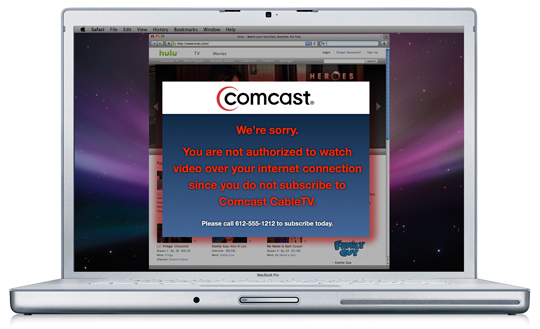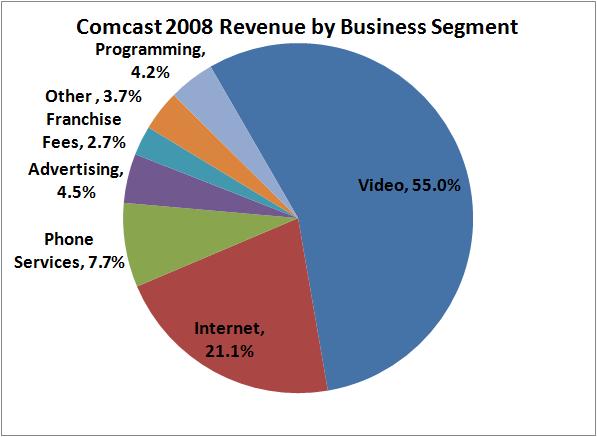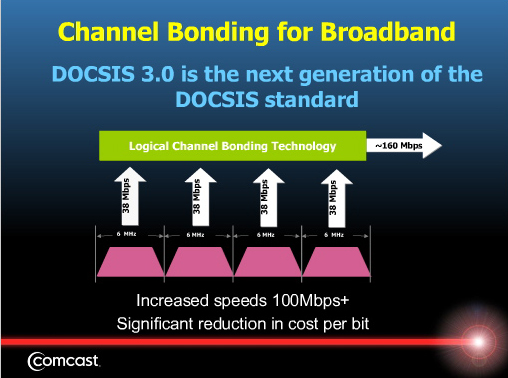 Are you enjoying the ability to watch TV shows and movies streamed through the internet to your computer or media center with the likes of Hulu, Joost and all the others? If the cable companies and other network providers have their way, your connection will need to be “authenticated” — verifying that the location of your internet connection also subscribes to cableTV — before you’d be able to watch video through your internet connection.
Are you enjoying the ability to watch TV shows and movies streamed through the internet to your computer or media center with the likes of Hulu, Joost and all the others? If the cable companies and other network providers have their way, your connection will need to be “authenticated” — verifying that the location of your internet connection also subscribes to cableTV — before you’d be able to watch video through your internet connection.
Like most strategic moves, this ‘authentication’ one seems benign on the surface. One provider, Comcast, is positioning the use of authentication only for their Hulu knockoff, Fancast, rather than for the competitive sites like Hulu itself. The way that authentication would work is that you’d start streaming a cableTV subscriber-only show or movie to your computer or media center, but then find that it would only be accessible to you if you also had a cableTV subscription!
How benign is this strategic and likely anti-competitive move? In my view, it’s not benign at all but rather setting the stage for the next phase of video delivery — already begun through the internet and accelerating rapidly — and for those who already control your internet connection to be in charge of what content can be delivered and whom can deliver it.
GigaOm‘s Chris Albrecht wrote a solid article here for BusinessWeek and Will Richmond dug a little deeper in this one on VideoNuze. Albrecht pointed out the following which I immediately saw as the most likley rationale for cable companies and others to move forward with authentication as one of the first control measures for video delivery over the internet:
Multi system operators (e.g. cable companies) pay networks big fees to carry programming, and as such are unhappy that networks are turning around and putting that content online for free. The result? Cable and media companies like Comcast (CMCSA) and Time Warner (TWX) are developing plans that require viewers to prove they have a subscription to an MSO before they can watch video online. Comcast is calling its plan “On Demand Online” and Time Warner’s is dubbed “TV Everywhere.”
So why am I concerned about the possibility that the MSO’s are trying to muscle their way in to internet delivery of video? How about the fact that my new Mac mini media center has exploded our use of streaming video and opened my eyes to the dizzying array of video channels, new offerings from services like NetFlix ($8.99 to stream hundreds of movies instantly), and amazing, innovative and quality tech channels like Revision3? Also, why does this strengthen my belief that the Minnesota Ultra High Speed Broadband Task Force must recommend regulations for all MSO’s to our State Legislature this fall?
When I wrote, “Internet Providers Want Control Over Your TV” and the followup, “Control Over Your TV: A Comcast Executive Discussion” primarily about the strategic move of Comcast’s 250GB cap (to make consumers wary of signing up for competitive video services or making media center-like hardware or software investments), I’m pretty certain that my skepticism over the purity of the motives of my home and business services provider, Comcast, was glaringly obvious.
While I truly do laud the investments they’re making (e.g., DOCSIS 3.0, and the upcoming 4.0, promising speeds of up to 160mbps up-n-down; building two new data centers in Denver, CO and Philadelphia, PA to accelerate on-demand video delivery and caching) I completely understand that many of these investments are an absolute necessity if Comcast is to position themselves strategically and ultimately act as a toll taker for internet video distribution.
What’s potentially the motivation behind what I’m suspecting is an attempt by MSO’s to be the internet video distributors of tomorrow? One word: revenue. In Comcast’s case, more than 50% of their revenues are driven by video distribution. Comcast has zero incentive to provide an uncontrolled, level playing field for others to distribute their video content through the cable that Comcast owns.
It’s a good thing that they have so much strength in cableTV distribution. However, by owning both the internet pipe and the distribution of video content coming through it, it’s as if they owned both the tollway and the biggest trucking company, and were taking steps to ensure that no other trucking companies would be able to compete fairly on their tollway.
 Comcast 2008 Revenue by Segment Source: Wikiinvest
Comcast 2008 Revenue by Segment Source: Wikiinvest
INTERNET VIDEO
Consumer interest in internet TV viewing is growing, according to a recent study from consulting firm Accenture. Mirroring what’s happening with other traditional media types and access to that content with any internet connected device, it probably comes as no surprise that their report discovered that TV viewing is also being done across platform types like computers, phones, and media centers. The good news/bad news? Overall viewership of TV and video programming is up, but 74 percent of the study’s 14,000 respondents said they would “enjoy watching TV on their computer.”
The biggest revelation in Accenture’s study was that respondent’s also expressed a lack of loyalty towards branded channels. They loved their shows but didn’t really care where they watched them.
According to “Video-Enabled Home Network Nodes – A Global Analysis & Forecast” from The Diffusion Group, the number of global broadband households will near 440 million by 2010 and top 1.2 billion by 2030. During that same time, the number of broadband-enabled home networks will grow from 150 million in 2010 (34 percent of broadband homes) to more than 1.0 billion in 2030 (83 percent of broadband homes). With such infrastructure in place, the opportunity for broadband-enabled services – especially video – will grow dramatically.
So I guess the question is this: what would you do if you were Comcast and 55% of your revenues were at stake or were any MSO that would like to be the exclusive video provider through your internet connection?
- If you are Comcast, build a mechanism called ‘authentication’ — ostensibly only for your owned internet video site, FanCast — and once this is in place and the bugs worked out, make every content provider adhere to your standards and disallow any content you deliver, being delivered by them for free or at some other fee structure
- You’d continue building out your national backbone to eliminate dependencies on other providers and increase speeds
- You’d simultaneously get ready for massive amounts of cached video — so that you would be the primary method and provider of choice for internet video delivery (and maybe the only provider?) — by building data centers and beefing up your local network storage
- Lastly, you’d leverage your incumbent coaxial cable network by performing “Logical Channel Bonding” in order to combine channels and deliver hugely fast ~160mbps internet delivery to homes and businesses. By offering up that sort of speed, a rate no other provider but those few who’ve deployed expensive fiber optic cable can match, you’d continue to accelerate your lead, consolidate your power and control, and ensure that you own this next major wave of internet content delivery: video over the internet.

There’s only one problem: The United States government has historically taken a dim view of monopolies and one could argue that being the dominant internet provider is one thing, but controlling the infrastructure, control and application layers extends the monopoly in to too many areas of control (e.g., Comcast traffic shaping or alleged anti-competitive application blocking with Vonage in order to protect their own Digital Voice service).
As I write this, it sure seems like I’m anti-Comcast. I’m not. It’s just that they’re my provider at both home and my business and any regulations I urge would be in place for all MSO’s and internet service providers. While I’m anti-monopoly, I’m more pro-internet and it’s crystal clear to me that the internet is more important to the future of Minnesota and our nation than were the railroad, telephone, or interstate highway system could ever have been. The internet is connecting the entire globe and there’s too much at stake to allow single points of internet provider control with the infrastructure, control and applications layers of their services. We simply cannot allow internet providers control over their competitors and the disruptive innovations that always emerge.
Comcast, Time Warner, Verizon and all the other companies winning and maximizing their revenues is critical but they need incentives, and those incentives must be aligned with those of the public.
TAKE ACTION
So what should you do now? While the Obama Administration is working toward a national broadband policy, if you care about high-speed broadband and how much control one (or a handful) of companies have over it, I’d urge you to make your voice heard by connecting NOW with the Minnesota Ultra High Speed Task Force members and let them know why and how this issue matters to you.
The task force needs to hear from you. It will be making recommendations to our State Legislature this fall, and key portions of those recommendations are being formulated as you read this post. If members don’t hear from you and soon, they’ll never know an open, unfettered Internet matters as much as we online participants do.
Minnesota Ultra High Speed Task Force Member Emails (full contact info here). Task Force chair, Rick King, has asked that all email correspondence be directed to Diane Wells (email) who is compiling them and releasing a weekly digest to the members.